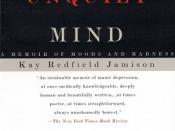Is there a Link between Creativity and Mood Disorders?
For generations creative people have dealt with the stigma of mental disorder often attributed to them. The "mad" scientist, frenzied artist and profoundly intense writer; all have been common judgments of these professions for years. Despite the prevalence of these beliefs, psychological studies in this field have been sparse and often inadequate. To fill this investigative void, Ruth Richards and Dennis Kinney, Nancy Andreasen, and Kay Jamison developed studies to examine the link between creativity and mood disorders more completely and accurately.
Early studies of this social stereotyping phenomenon were largely anecdotal, relying on the unconfirmed psychological diagnosis of creative individuals post-mortem. Examples of this include William Blake, Lord Byron, and Alfred, Lord Tennyson who were suspected to have had radical mood swings. Painters like Vincent van Gogh, Georgia O'Keeffe, Charles Mingus, and Robert Schumann were similarly afflicted.
Modern writers' mental states have also been studied with the aid of verifiable evidence. John Berryman, Randal Jarrell, Robert Lowell, Sylvia Plath, Theodore Roethke, and Anne Sexton were all hospitalized for mania or depression (Jamison, 1995). Jamison notes that "a high number of established artists- far more than can be expected by chance- meet the diagnostic criteria for manic depression or major depression...In fact, it seems that these diseases sometimes enhance or otherwise contribute to creativity in some people" (Jamison, 1995). It is not enough, however, to rely on frequency alone to support the link between creativity and mood disorders.
2
Recent studies have attempted to demonstrate this in a more concrete way with studies of modern artists and writers. In 1987, Nancy Andreasen used 30 creative writers, 30 matched controls, relatives of both groups to demonstrate the rate of mental illness in creative individuals. The study was preformed at...


